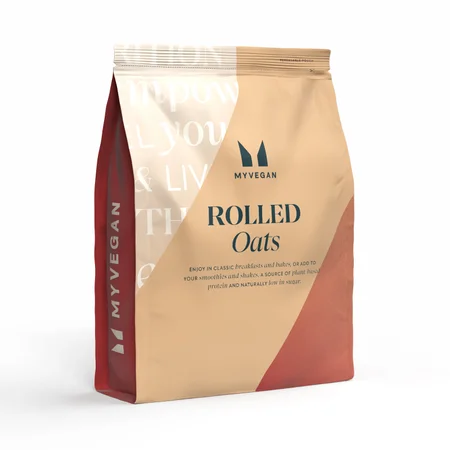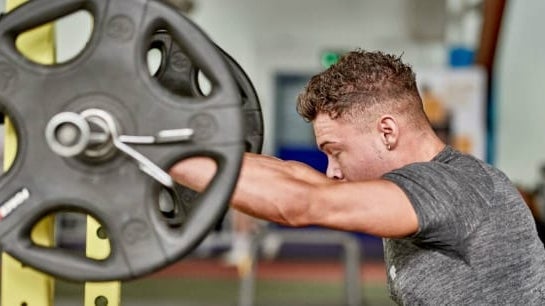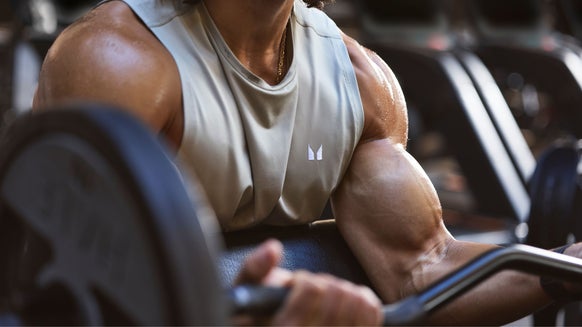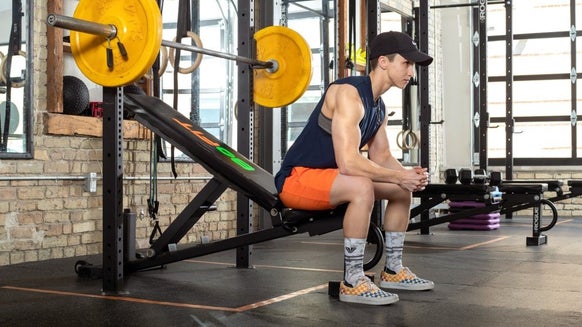The Dumbbell Front Raise Exercise | Form & Technique
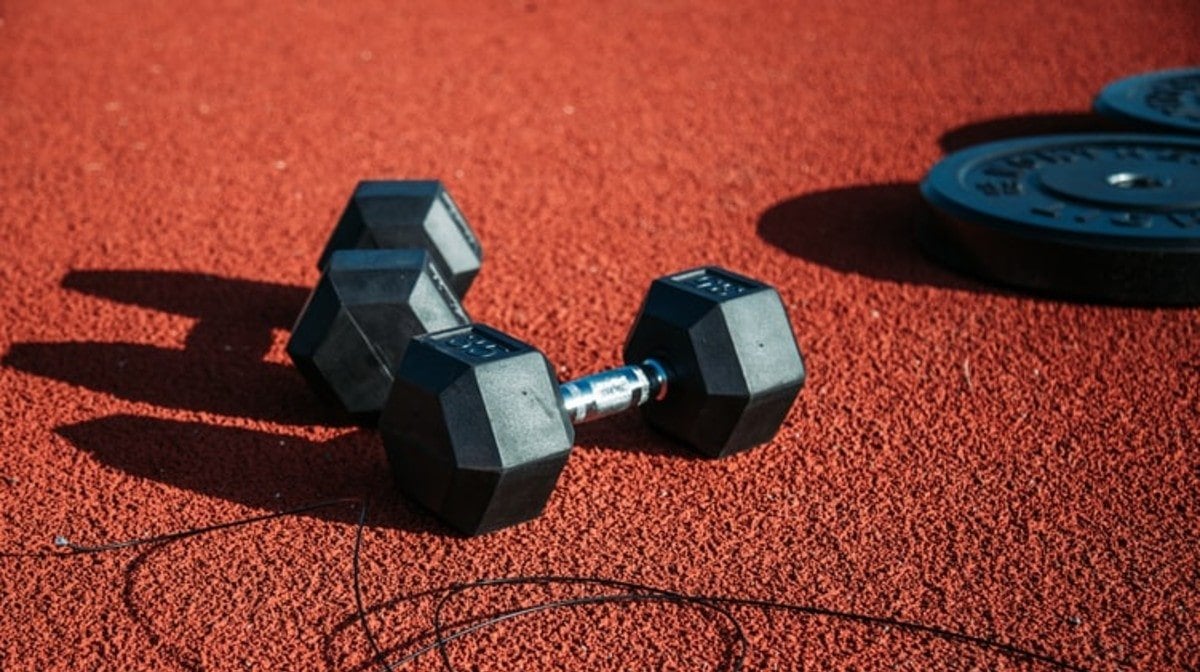
When training the shoulders, this typically refers to the deltoid muscles that surround the glenohumeral joint (the ball and socket joint of the shoulder). There are three heads to the deltoids: the anterior, lateral and posterior.
Compound movements such as the overhead press or isolations such as the lateral raise can be great for developing the lateral head, and posterior flyes or rowing movements can help to develop the posterior head. While the anterior head is used as a synergist (a supporting muscle) in pressing movements such as the bench press, the majority of the load is managed by the pecs and the triceps, minimising the effective loading of the anterior deltoid – and thus limiting its development.
As with any muscle group, if the goal is hypertrophy, then including isolations for specific muscles is key to developing a well-rounded physique. Since the anterior deltoid is responsible predominantly for flexion of the shoulder, we want to load that movement, using an exercise such as the

In this article:
Dumbbell Front Raise Benefits
Anterior Deltoid Isolation
The front raise is the best exercise to use when looking to develop size and shape in the front aspect of the shoulder, or the
Bi-lateral and Unilateral Application
Pre-Exhaust Method
A pre-exhaust exercise is where we pre-fatigue a body part using an isolation exercise first before initiating a compound movement. The dumbbell front raise can be an extremely effective isolation exercise in pre exhausting the anterior deltoids, helping to ensure the muscle is being ‘activated’ or stimulated enough for the following compound. This is essentially just another method of ensuring all of the motor units in a muscle are fatigued after a set, thus increasing the effectiveness of our hypertrophy-based training.
How to Perform the Dumbbell Front Raise
Whilst standing straight upright, grab two dumbbells and hold them on the front of your thighs with your palms facing towards your body (known as a pronated grip). Without swinging, lift the dumbbells forwards and to the front whilst keeping your hands facing downwards. As this exertion part of the movement is being performed, exhale your breath in a controlled manner. Maintain a slight bend in the elbows throughout. Once the weight is being lifted to around eye level, squeeze the deltoid and pause briefly. When the muscle has been effectively isolated and squeezed at the top point of contraction (i.e., when the dumbbell/hand is parallel to the ground/level with the shoulder), slowly release the dumbbell back to the starting position. As one of the dumbbells is lowered to the starting position, continue to repeat the previous exercise performed with the other arm for the designated amount of reps.
Common Mistakes
Not Warming Up Correctly
Swinging and Not Staying Upright
Locking Out the Elbow

Dumbbell Front Raise Variations
Double-Arm Dumbbell Front Raise
Whilst standing straight upright, grab two dumbbells and hold them on the front of your thighs with your palms facing towards your body (known as a pronated grip). Without swinging, lift the dumbbells forwards and to the front whilst keeping your hands facing downwards. As this exertion part of the movement is being performed, exhale your breath in a controlled manner. Maintain a slight bend in the elbows throughout. Once the weight is being lifted to around eye level, squeeze the deltoid and pause briefly. When the muscle has been effectively isolated and squeezed at the top point of contraction (i.e., when the dumbbell/hand is parallel to the ground/level with the shoulder), slowly release the dumbbell back to the starting position. - As one of the dumbbells is lowered to the starting position, continue to repeat the previous exercise performed with the other arm for the designated amount of reps.
Barbell Front Raise
Start standing upright, grab a barbell with the appropriate load and hold it in front of your thighs with your palms facing towards your body (known as a pronated grip). Without swinging, lift the dumbbells forwards and to the front whilst keeping your hands facing downwards. As this exertion part of the movement is being performed, exhale your breath in a controlled manner. Maintain a slight bend in the elbows throughout. Once the weight is being lifted to around eye level, squeeze the deltoid and pause briefly. - When the muscle has been effectively isolated and squeezed at the top point of contraction (i.e., when the barbell/hand is parallel to the ground/level with the shoulder), slowly release the barbell back to the starting position.
Cable Front Raise
Whilst standing straight upright, grab one cable, using the stirrup attachment, and hold it in front of your thighs with your palms facing towards your body (known as a pronated grip). Without swinging, lift the cable forwards and to the front whilst keeping your hands facing downwards. As this exertion part of the movement is being performed, exhale your breath in a controlled manner. Maintain a slight bend in the elbows throughout. Once the weight is being lifted to around eye level, squeeze the deltoid and pause briefly. When the muscle has been effectively isolated and squeezed at the top point of contraction (i.e., when the cable/hand is parallel to the ground/level with the shoulder), slowly release the cable back to the starting position. Make sure to perform this exercise on both sides. You may need to use slightly lower loads than usual, depending on the cable machine in your gym.
Dumbbell Front Raise FAQs
What muscles do dumbbell front raises work?
Predominantly, the anterior deltoid which is in the front aspect of your shoulder. Other muscles, such as the serratus anterior, pectoralis minor and biceps brachii will act as synergists, assisting in the exercise.
Is the front raise bad for your shoulders?
READ THESE NEXT:
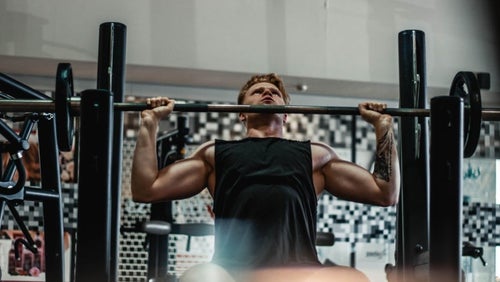
The Best Chest Day Exercises To Sculpt Your Upper Body
Get a killer chest pump.
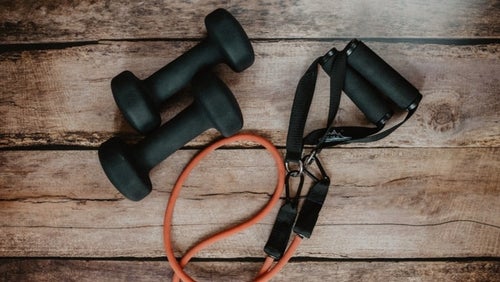
How To Master Hamstring Curls | Techniques and Common Mistakes
Buckle in for a masterclass in hamstring curls.


